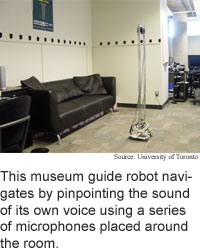
Robot guided by its voice
By
Kimberly Patch,
Technology Research NewsTwo years ago, when University of Toronto researcher Parham Aarabi tried to use one of the University's Artificial Perception Lab robots to give tours to the several dozen high school students, corporate personnel, professors and journalists who traipse through the facility every year, he ran into implementation problems.
"I thought that using one of our robots for a lab tour guide would be good idea," said Aarabi. The robot has a motorized base and speakers that play pre-recorded phrases at appropriate locations. "The problem was that this robot... was rather inaccurate in its motions," said Aarabi.
The problem spurred Aarabi and his students to devise a relatively simple way for the robots to navigate more accurately. Instead of mimicking human sight-based methods, the researchers turned to sound. "Since my students and I had been working on microphone-array-based sound localization, the idea just came to us to combine robot navigation and sound source localization."
As the lab's revamped robot tour guide explains the importance of various stations on a lab tour, every phrase it says is recorded by 24 microphones embedded in the wall, said Aarabi. "After some signal processing, the microphone array determines what location the sound came from." The system requires about two seconds of sound to get enough information to peg the robot's location.
The robot also has whisker-like touch sensors that determine when an object is in its path. When this happens it backs up, reorients itself and plots a new course around the obstacle. The obstacle's location is stored in memory so the robot can avoid it in the future.
Designing the system as a whole and integrating all the sub-components was the hard part, he said. This included crunching the data from the 24 microphones to compute the robot's location in real-time and coordinating the information with the robot's control and navigation systems. Given the location of the robot and its destination, it was a fairly simple task for a computer to compute the best route, he said.
The navigation system is accurate to 7 centimeters. "Ours is not the most accurate method, however it is perhaps the simplest and cheapest approach," said Aarabi.
In its sub-functional form, the robot seemed like a mechanical device or tool, but when the parts were all combined "it almost took on a new personality," said Aarabi. "I guess that's what happens when a 1.6 meter-tall object moves in a seemingly intelligent fashion around a room and makes interesting remarks," he said.
The next step is to make the robotic tour guide more intelligent, said Aarabi. "In other words, enable it to ask, understand, and answer the questions that are asked of it," he said.
This is no small task. "It requires robust speech recognition, natural language processing and understanding, followed by interpreting the question that was asked," said Aarabi.
The sound navigation system could be used in tour guide applications that don't require speech recognition and understanding with a year or two, said Aarabi. More elaborate systems that recognize speech are further off, he said.
The sound navigation system could eventually be used as a component of a multimodal navigation system that combines sound and cameras to provide very accurate navigation, according to Aarabi.
Aarabi's research colleagues were Qing Hua Wang and Teodor Ivanov. The work appeared in the November 14, 2003 issue of Information Fusion. The research was funded by the Natural Science and Engineering Research Council of Canada, the University of Toronto, the Canada Foundation for Innovation, and the Ontario Innovation Trust.
Timeline: > 2 years, 3 years
Funding: Government, University, Institute
TRN Categories: Robotics; Applied Technology
Story Type: News
Related Elements: Technical paper, "Acoustic Robot Navigation Using Distributed Microphone Arrays," Information Fusion, November 14, 2003
Advertisements:
April 7/14, 2004
Page One
Net plan builds in search
Robot guided by its voice
Angle speeds plastic transistor
Sturdy quantum computing demoed
Briefs:
DNA folds into paired pyramids
Fiber spun from nanotube smoke
Material boosts thermoelectricity
Nano ribbons coil into rings
Simulation maps nano patterns
Chip-camera combo tracks viruses

News:
Research News Roundup
Research Watch blog
Features:
View from the High Ground Q&A
How It Works
RSS Feeds:
News
Ad links:
Buy an ad link
| Advertisements:
|
 |
Ad links: Clear History
Buy an ad link
|
TRN
Newswire and Headline Feeds for Web sites
|
© Copyright Technology Research News, LLC 2000-2006. All rights reserved.